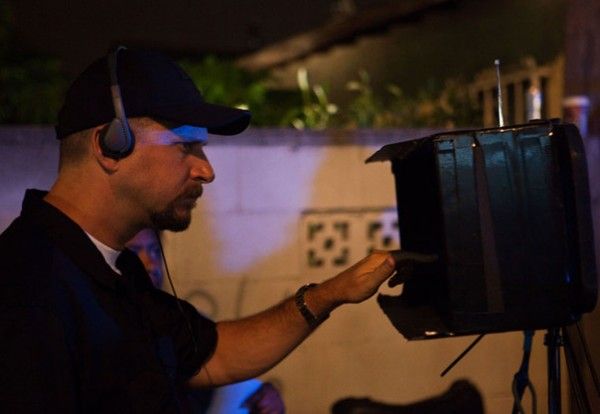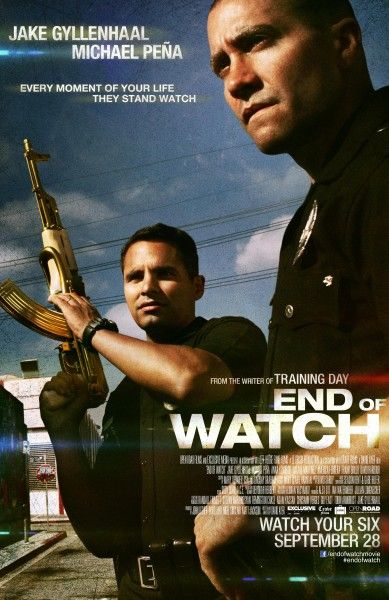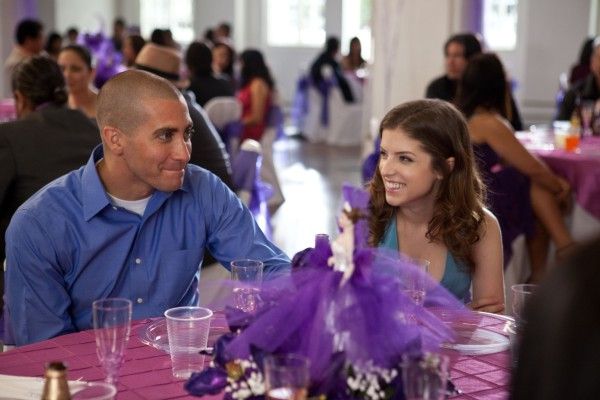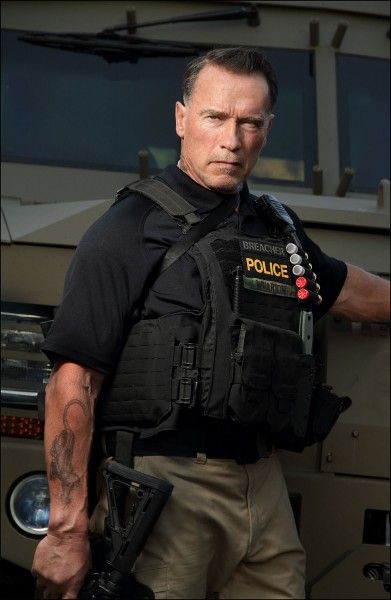The gritty and intense crime drama End of Watch, available on DVD/Blu-ray on January 22nd, tells the story of LAPD officers Brian Taylor (Jake Gyllenhaal) and Mike Zavala (Michael Peña), who patrol the mean streets of South Central Los Angeles. Shot documentary-style, the action unfolds through footage from the handheld HD cameras of the police officers, gang members, surveillance cameras and citizens caught in the line of fire to illustrate how cops risk their lives, every day.
During this recent exclusive phone interview with Collider, writer/director David Ayer talked about how relieved he was with the film’s success, how much audiences responded to the characters’ relationship and the actors’ performances, how he gauges which scenes to cut and which scenes to keep, including his original alternate ending with the deleted scenes, and why he finds himself so drawn to cop stories. He also talked about the experience he had directing Arnold Schwarzenegger on Ten, about members of an elite DEA task force who find themselves being taken down one-by-one after they rob a drug cartel safe house, how the action in that film compares to the action in his previous films, the stylistic approach he took, how he hopes to take the film to Comic-Con, and that he’s currently writing a World War II tank movie. Check out what he had to say after the jump, and be aware that there are some spoilers.
Collider: What are your thoughts on the success of the film?
DAVID AYER: I was relieved. You make a movie and it’s like convincing people to go on an expedition with you. You think you know where it’s going to end up, and you’re hoping and guessing. But, when people trust you and get involved, based on that trust, it’s a really nice feeling to be able to have everything pay off.
Did you have a moment when you realized it was actually a hit movie?
AYER: No, not really. It was nice to be #1 on opening weekend, but I was actually in the middle of filming something else. I had to work!
When you started getting feedback from people who had seen it, what did you find that they were responding to the most?
AYER: The characters’ relationship and the performance that Jake [Gyllenhaal] and Mike [Peña] created together that had become so convincing. What I always hoped would make that movie work was the chemistry, and I think that was the case.
Are you the type of filmmaker who watches something months or years down the road and wishes you could change something about it, or are you of the mind-set that once it’s done, it’s done?
AYER: You know, you can’t go back. Once it’s done, it’s done. I’m sure there will be things that I would love to change about it, in the future, but each movie is a snapshot of its time and the resources, and you do your best on it. There’s a saying that movies are never finished, they’re just abandoned.
Is it fun, then, to go back and do the audio commentary for the DVD/Blu-ray, once you’ve had a little distance from the film?
AYER: Absolutely! You don’t know what it is you’re making until it’s made and people tell you what it is. It’s always interesting to go back with that eye and go, “Oh, okay, that’s what I was doing.” You have an idea and you have a map, but it’s always very emotional. It’s nice when it resonates.
What are you feelings about including deleted scenes on the DVD/Blu-ray? Do you feel like deleted scenes are deleted for a reason, or can you understand why they’re of interest to people?
AYER: I think it’s great! I think people can get inside the plastic nature of movies. There were scenes I cut that I never thought I would cut, and there are scenes in the movie that I never thought would be in the movie. It’s a system. It’s like a car engine. Even though scenes are powerful, you’re like, “I guess I don’t need that extra bit because the engine is not configured like that?”
When you mentioned cutting scenes you didn’t think you’d have to cut, does that just become a very instinctual thing, when you have to decide what to ultimately cut?
AYER: It’s research and development. When you put a movie together, you’re continually screening it for yourself and you’re screening it for other people. It’s like a video game power meter. When the power bar starts going down, you’ve gotta look at what’s going on. Even though there are these great scenes, all stacked up, it can be one too many, or you’re just not getting to the point of the movie quick enough. It’s a fine dance
In watching the deleted scenes, it becomes apparent that you shot another ending of the film, where both of your main characters died.
AYER: Yes.
How did you ultimately decide which of those endings you wanted to use? Was that a difficult decision to make?
AYER: I shot both endings for safety. The original idea was that both guys would get killed. I guess I just fell in love with the characters and I couldn’t bear to kill them both. I was also worried about the audience being fully traumatized, coming out of the theater. So, ultimately I had one live.
Where did your interest in telling cop stories come from, and is it something you think you’ll continue to explore?
AYER: It’s just a world I’m so familiar with, and I keep getting drawn back into it. There’s just endless drama. It’s life-and-death, and there’s violence and danger. All the things that make for good drama are present. But, I definitely want to spread my wings and explore different arenas and genres, and really open myself up because it’s really to get typecast.
You have some female cops in the film, but don’t follow them too much. Would you like to further explore what being a cop is like for a woman?
AYER: Yeah! It’s a different world now. They’re pretty much accepted. Any cop has to prove themselves on the street, regardless of race or gender, these days. That’s the world of policing. I’ve met some bad-ass female cops, who are very cool people.
You had such an interesting visual style for End of Watch. Once you were on set, did you find that that style had advantages or limitations that you weren’t expecting it to have?
AYER: End of Watch started out as this found-footage idea, and then ultimately involved into a mix of both found-footage and traditional photography. I decided not to limit myself, pretty early on, and used whatever technique or camera style would work best to tell the story. I broke the rules, in that regard.
How did the shoot for Ten go, and what was it like to direct someone like Arnold Schwarzenegger, who is so iconic for his action work?
AYER: You’re working with a legend. He’s amazing! He’s very professional and just very cool and open to everything. He really let me direct him. We wanted to create a real character together, and not just an action-y hero role. We explored something very different for him, but at the same time, for the people that know and love him, as this action icon, that’s there, too. I was worried and thought, “This guy’s the former governor of California. What’s going to go down on set?” But, when it’s 3 am and freezing cold and brutal, and you’ve got to ask him to do a stunt, he’s right there and he’s game. He’s a very down-to-earth guy. He’s a very regular guy, in a lot of ways.
How does the action in that film compare to the action you’ve done in your previous films?
AYER: It’s more and bigger. But, I like to do stuff real and practical and in camera, as much as possible. I don’t like doing these big CG things. I like old school filmmaking, and that’s really what this is.
Did you really plan everything out ahead of time, or did things change once you got on set?
AYER: Everything changes when you get on set. It’s all about planning. You plan and you sit there with your department heads and go over your day. When you make a movie, whatever’s been brought to set is what you’ve got and whoever is there is who you’ve got, so you hope you made the right decisions, early on. But, once all the pieces are there, for me, I direct with my gut and my instincts. I’ll switch stuff up.
What sort of stylistic approach did you decide to use, this time around?
AYER: It’s shot a little more traditionally, but it’s not conventional coverage. With every movie, you learn. Ten is my fourth movie, so I’m bringing all of my experience to the table. I had a great crew around me, and a lot of the same people from End of Watch. It just becomes more focused on making the movie and less about trying to figure out what your job is.
When do you think the first trailer for Ten will be done?
AYER: I have no idea!
Do you think you’ll take the film to Comic-Con?
AYER: I hope so, yeah! That would be great!
What are you currently working on writing now?
AYER: I’m working on a World War II tank movie.
Was there a specific inspiration for that, or was that something you were asked to write?
AYER: No, it’s a spec. It’s a crazy idea I had.
After working as a writer for so many years, are there things that you feel you’ve learned about the process that you’re able to apply to how you do it now?
AYER: It’s never easy, ever, but you get more confident in what you’re doing. Because I come from writing, as a director, it helps me keep the threads of story together, and I can make decisions on set and change things. For me, directing is like writing with meat. I can write live, in real time, and change things and be confident that I’m helping the movie.
The more successful you get, as a filmmaker, does it get harder to make time to write just for yourself?
AYER: Yeah, big time! You have to push everything away and find the time, otherwise it doesn’t get done.
With remakes and reboots being so commonplace now, does it feel like a necessary evil when you’re a writer-for-hire, or is the idea of re-imagining someone else’s work intriguing for you?
AYER: It is intriguing. It’s just the nature of the business. They like stuff with a history. It’s like free advertising because awareness is already there with the title. So, it’s part of the business, but there’s been some great remakes and some great franchises. It’s all about the right match.
There are rules to screenwriting and every writer has their own process. Are there rules that you always follow, and are there rules that you always avoid?
AYER: There are big rules, like a movie has to have a three-act structure and follow certain things. I feel like you’ve got to have a good, powerful ending. The movie has to be going somewhere. Other than that, you want it to be entertaining, but people usually disagree on what entertaining is and everybody has different tastes.
Because directing is such an all-consuming job, do you prefer to direct scripts that you’ve written?
AYER: It’s all about connecting. I’d be more than happy to direct someone else’s material, if I connect to it. For the directing process, it’s all the same. It’s so much work and it’s so intense that you have to connect to the material.
End of Watch is available on DVD/Blu-ray on January 22nd.




